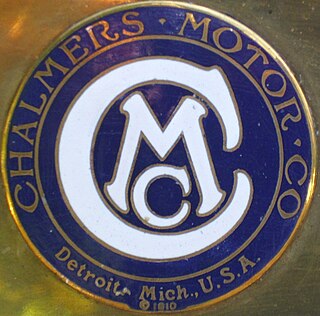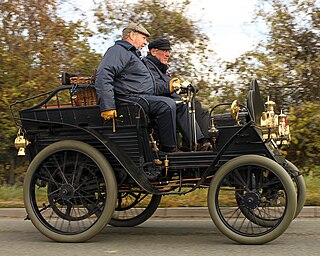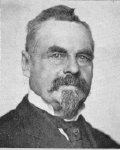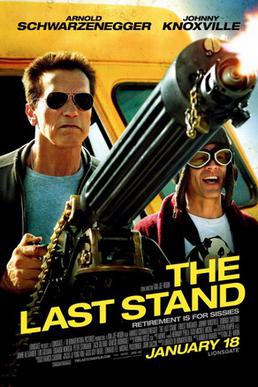Related Research Articles

The Chalmers Motor Company was an American automobile manufacturer headquartered in Detroit, Michigan. Founded in 1908 by Hugh Chalmers, the company was known for producing high-end vehicles. Chalmers automobiles gained recognition for their toughness, durability, and engineering receiving particular praise for their performance in touring events. The company reached its peak in 1911, becoming the eighth-largest auto producer in the United States. Despite initial success, the company faced challenges with increasing competition in the auto industry, and sales began to decline in the following years. In 1923, Chalmers Motor Company merged with Maxwell Motor, ultimately forming the basis for the Chrysler Corporation.

The E-M-F Company was an early American automobile manufacturer that produced automobiles from 1909 to 1912. The name E-M-F was gleaned from the initials of the three company founders: Barney Everitt, William Metzger, and Walter Flanders.
The Pere Marquette Railway was a railroad that operated in the Great Lakes region of the United States and southern parts of Ontario in Canada. It had trackage in the states of Michigan, Ohio, Indiana, and the Canadian province of Ontario. Its primary connections included Buffalo; Toledo; and Chicago. The company was named after Jacques Marquette, a French Jesuit missionary who founded Michigan's first European settlement, Sault Ste Marie.

The Brass Era is an American term for the early period of automotive manufacturing, named for the prominent brass fittings used during this time for such features as lights and radiators. It is generally considered to encompass 1896 through 1915, a time when cars were often referred to as horseless carriages.

The 1910 World Series was the championship series in Major League Baseball for the 1910 season. The seventh edition of the World Series, it was a best-of-seven playoff between the American League (AL) champion Philadelphia Athletics against the National League (NL) champion Chicago Cubs. The series was played from October 17 to 23, with the Athletics winning the series 4 games to 1, clinching the team's first World Series.

John Godfrey Parry-Thomas was a Welsh engineer and motor-racing driver who at one time held the land speed record. He was the first driver to be killed in pursuit of the land speed record.

Wolseley Motors Limited was a British motor vehicle manufacturer founded in early 1901 by the Vickers Armaments in conjunction with Herbert Austin. It initially made a full range, topped by large luxury cars, and dominated the market in the Edwardian era. The Vickers brothers died and, without their guidance, Wolseley expanded rapidly after the war, manufacturing 12,000 cars in 1921, and remained the biggest motor manufacturer in Britain.

The Jeffery brand of automobiles were manufactured by the Thomas B. Jeffery Company in Kenosha, Wisconsin.

The Mors automobile factory was an early French car manufacturer. It was one of the first to take part in automobile racing, beginning in 1897, due to the belief of the company founder, Émile Mors, in racing's technical and promotional benefits. By the turn of the century, automobile racing had become largely a contest between Mors and Panhard et Levassor.

Stevens-Duryea was an American manufacturer of Veteran and Brass Era automobiles in Chicopee Falls, Massachusetts, between 1901 and 1915 and Vintage Cars from 1919 to 1927.

Thomas Buckland Jeffery was a British emigrant to the United States who co-founded the Gormully & Jeffery company which made the Rambler bicycle. He invented the "clincher" rim which was widely used to fit tires to bicycles and early automobiles, and in 1900 established the Thomas B. Jeffery Company to make automobiles, again using Rambler branding.

The Owen Magnetic was a pioneering American brand of hybrid electric luxury automobile manufactured between 1915 and 1922. Car models of the brand were notable for their use of an electromagnetic transmission and were early examples of an electric series hybrid drivetrain. The manufacture of the car was sponsored by R.M. Owen & Company of New York, New York. The car was built in New York City in 1915, in Cleveland, Ohio, between 1916 and 1919 and finally in Wilkes-Barre, Pennsylvania, in 1920 and 1921.
Sir Alfred George Beech Owen was the son of Alfred Ernest Owen. Sir Alfred was educated at Emmanuel College, Cambridge and after the death of his father in 1929 he became, jointly with his brother, managing director of the Rubery Owen Group.

The Staver and Staver-Chicago was an American Brass Era automobile manufactured at 76th and Wallace Streets in Chicago, Illinois, by the Staver Carriage Company from 1906 until 1914.

The Matheson was a luxury American automobile manufactured from 1903 to 1912, first in Grand Rapids, Michigan, then Holyoke, Massachusetts and from 1906 in a purpose-built factory in Forty Fort, Wilkes-Barre, Pennsylvania.

Mitchell was a major brass-era automobile marque in Racine, Wisconsin, from 1903 to 1923.

The Last Stand is a 2013 American action thriller film directed by Kim Jee-woon. The film stars Arnold Schwarzenegger in the lead role, alongside Forest Whitaker, Johnny Knoxville, Rodrigo Santoro, Jaimie Alexander, Luis Guzmán, Eduardo Noriega, Peter Stormare, Zach Gilford and Genesis Rodriguez. This was Arnold Schwarzenegger's first lead acting role since Terminator 3: Rise of the Machines in 2003. In the film, a tough small town sheriff and his deputies must stop a dangerous drug lord from escaping to Mexico in a modified sports car.
Weidely Motors Company was an early motor company based in Indianapolis, IN. Weidely started in 1915. It made engines for Premier, Chalmers, Cletrac crawlers and Owen Magnetic cars. They also made a V-12 engine for the 1917 Pathfinder and 1920 Heine-Velox, as well as the 1916-1918 Austin, Hal and Kissel cars.
The Welch Motor Company was an American automobile company headquartered in Chelsea, Michigan. It began in 1901 and continued production of luxury vehicles until 1911 when it merged with General Motors.
References
- 1 2 3 Kimes, Beverly (1996). Standard Catalog of American Cars 1805-1942. Krause publications. ISBN 0-87341-428-4.
- ↑ Automotive Industries. Vol. 21. Chilton Company, Incorporated. 1909. p. 499. ISSN 0005-1527. Archived from the original on 2024-05-18. Retrieved 2015-08-26.